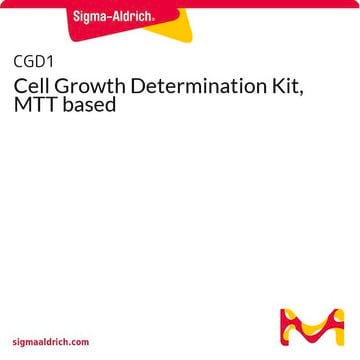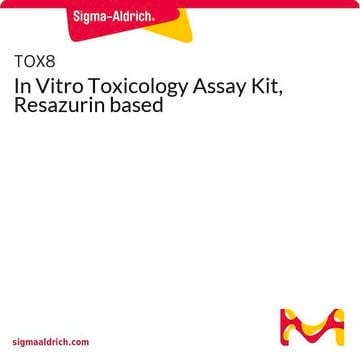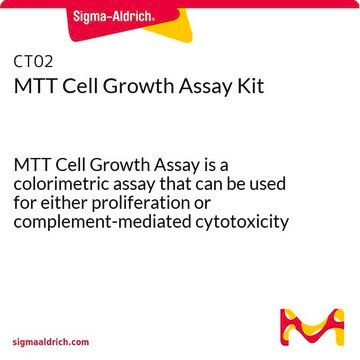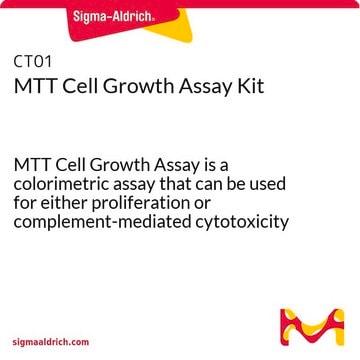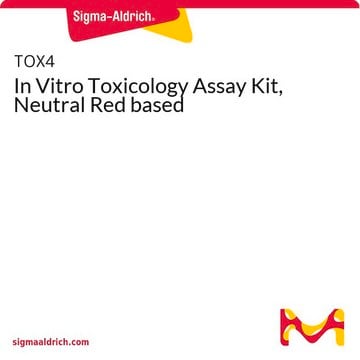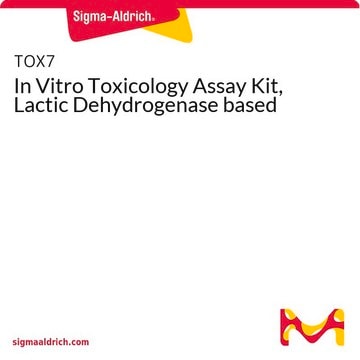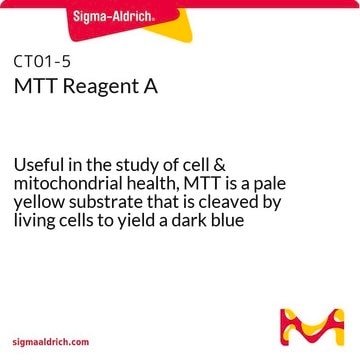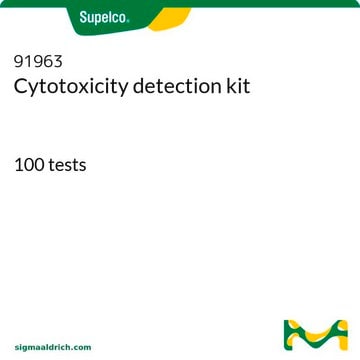The MTT asay is a method to assess cell viability. This assay is a semiquantitative assay. The assay is used to compare the viability changes in treated cells to untreated cells. The absorbance is indicative of the cell number. The higher the absorbance, the greater the number of viable cells present. Most researchers compare the absorbance of the two samples as a ratio (ABS treated cells/ABS untreated cells) to get a fold increase/decrease in cell number.
TOX1
In Vitro Toxicology Assay Kit, MTT based
Synonym(s):
mitochondrial activity assay
About This Item
Recommended Products
usage
1 kit sufficient for 1,000 tests
packaging
pkg of 1 kit
storage condition
dry at room temperature
λmax
570 nm
application(s)
cell analysis
detection
detection method
colorimetric
storage temp.
2-8°C
General description
Application
Biochem/physiol Actions
related product
Signal Word
Danger
Hazard Statements
Precautionary Statements
Hazard Classifications
Aquatic Acute 1 - Aquatic Chronic 2 - Eye Dam. 1 - Flam. Liq. 2 - Muta. 2 - Skin Corr. 1 - STOT SE 3
Target Organs
Central nervous system, Respiratory system
Storage Class Code
3 - Flammable liquids
Flash Point(F)
53.6 °F
Flash Point(C)
12 °C
Choose from one of the most recent versions:
Already Own This Product?
Find documentation for the products that you have recently purchased in the Document Library.
Customers Also Viewed
Articles
Quality control guidelines to maintain high quality authenticated and contamination-free cell cultures. Free ECACC handbook download.
Cell based assays for cell proliferation (BrdU, MTT, WST1), cell viability and cytotoxicity experiments for applications in cancer, neuroscience and stem cell research.
-
Is the MTT assay quantitative?
1 answer-
Helpful?
-
-
What is the Department of Transportation shipping information for this product?
1 answer-
Transportation information can be found in Section 14 of the product's (M)SDS.To access the shipping information for this material, use the link on the product detail page for the product.
Helpful?
-
-
What is the difference between product CGD1, Cell Growth Determination Kit and product TOX1, In Vitro Toxicology Assay Kit?
1 answer-
Product CGD1 and TOX1 are both MTT based assays. The major difference between product CGD1 and TOX1 is that TOX1 contains 10 % Triton X-100 in the solubilization solution for better lysis of the cells and solubilization of the MTT. If there is complete cell lysis, the results obtained with both kits would be the same. The MTT in this kit is a solution, whereas the TOX1 assay kit contains the MTT as a powder that is solubilized before use.
Helpful?
-
Active Filters
Our team of scientists has experience in all areas of research including Life Science, Material Science, Chemical Synthesis, Chromatography, Analytical and many others.
Contact Technical Service